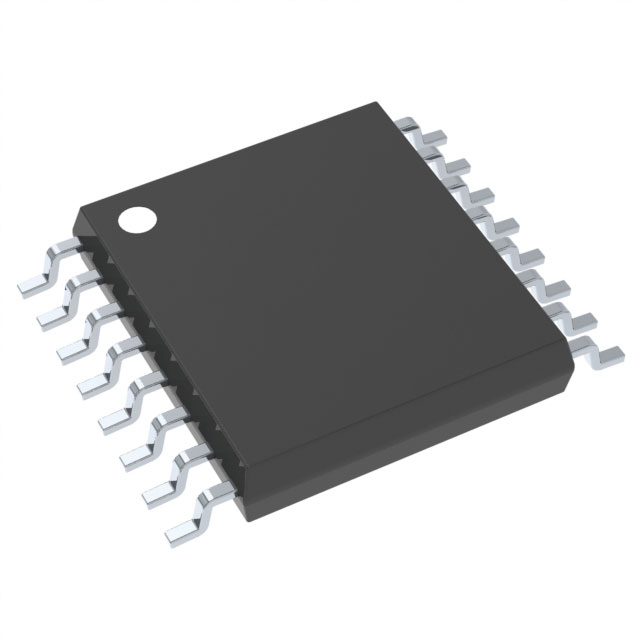Xem thông số kỹ thuật để biết chi tiết sản phẩm.

SN74HC138QPWRQ1
Product Overview
Category
SN74HC138QPWRQ1 belongs to the category of integrated circuits (ICs).
Use
It is commonly used in electronic devices for decoding and demultiplexing applications.
Characteristics
- High-speed CMOS technology
- Low power consumption
- Wide operating voltage range
- Schmitt-trigger inputs for noise immunity
- 3-to-8 line decoder/demultiplexer functionality
Package
SN74HC138QPWRQ1 is available in a small-sized TSSOP package.
Essence
The essence of SN74HC138QPWRQ1 lies in its ability to decode and demultiplex multiple input signals into separate output lines.
Packaging/Quantity
SN74HC138QPWRQ1 is typically packaged in reels, with each reel containing a specific quantity of ICs. The exact quantity may vary depending on the manufacturer's specifications.
Specifications
- Supply Voltage: 2V to 6V
- Input Voltage: 0V to Vcc
- Output Voltage: 0V to Vcc
- Operating Temperature Range: -40°C to +125°C
- Logic Family: HC
- Number of Inputs: 3
- Number of Outputs: 8
Detailed Pin Configuration
SN74HC138QPWRQ1 has a total of 16 pins, which are assigned specific functions as follows:
- GND: Ground reference
- A0: Input line 0
- A1: Input line 1
- A2: Input line 2
- Y0: Output line 0
- Y1: Output line 1
- Y2: Output line 2
- Y3: Output line 3
- Y4: Output line 4
- Y5: Output line 5
- Y6: Output line 6
- Y7: Output line 7
- Vcc: Positive power supply
- E1: Enable input 1
- E2: Enable input 2
- E3: Enable input 3
Functional Features
SN74HC138QPWRQ1 offers the following functional features:
- Decodes a 3-bit binary input into one of eight active-low outputs.
- Enables cascading multiple ICs for larger decoding applications.
- Provides Schmitt-trigger inputs to ensure noise immunity and reliable operation.
Advantages and Disadvantages
Advantages
- High-speed operation allows for efficient signal decoding.
- Low power consumption makes it suitable for battery-powered devices.
- Wide operating voltage range provides flexibility in various applications.
- Schmitt-trigger inputs enhance noise immunity, ensuring accurate decoding.
Disadvantages
- Limited number of inputs and outputs restricts its use in complex systems.
- TSSOP package may require specialized equipment for soldering and handling.
Working Principles
SN74HC138QPWRQ1 operates based on the principles of digital logic. It takes a 3-bit binary input and decodes it into one of eight possible output lines. The enable inputs (E1, E2, and E3) control the selection of the output line based on the input combination. When an enable input is low, the corresponding output line becomes active-low, allowing the decoded signal to be utilized in subsequent circuitry.
Detailed Application Field Plans
SN74HC138QPWRQ1 finds applications in various fields, including:
- Address decoding in microcontrollers and microprocessors.
- Memory selection in RAM and ROM modules.
- Signal routing in communication systems.
- Display multiplexing in LED and LCD panels.
- Data demultiplexing in data acquisition systems.
Detailed and Complete Alternative Models
Some alternative models that offer similar functionality to SN74HC138QPWRQ1 include:
- 74LS138: A TTL logic family equivalent of SN74HC138QPWRQ1.
- CD74HC138E: Another CMOS-based decoder/demultiplexer IC.
- 74HC238: A higher pin-count version with additional features.
These alternative models can be considered based on specific requirements and compatibility with existing circuitry.
Word count: 526 words
Liệt kê 10 câu hỏi và câu trả lời thường gặp liên quan đến ứng dụng SN74HC138QPWRQ1 trong giải pháp kỹ thuật
Sure! Here are 10 common questions and answers related to the application of SN74HC138QPWRQ1 in technical solutions:
1. What is SN74HC138QPWRQ1? - SN74HC138QPWRQ1 is a high-speed CMOS 3-to-8 line decoder/demultiplexer IC.
2. What is the purpose of SN74HC138QPWRQ1? - SN74HC138QPWRQ1 is used to decode binary information from a microcontroller or other digital devices into separate output lines.
3. What is the voltage supply range for SN74HC138QPWRQ1? - The voltage supply range for SN74HC138QPWRQ1 is typically between 2V and 6V.
4. How many input lines does SN74HC138QPWRQ1 have? - SN74HC138QPWRQ1 has three input lines (A0, A1, and A2) that can be used to select one of the eight outputs.
5. What is the maximum output current of SN74HC138QPWRQ1? - The maximum output current of SN74HC138QPWRQ1 is 25mA per output.
6. Can SN74HC138QPWRQ1 be used with both TTL and CMOS logic levels? - Yes, SN74HC138QPWRQ1 is compatible with both TTL and CMOS logic levels.
7. What is the propagation delay of SN74HC138QPWRQ1? - The propagation delay of SN74HC138QPWRQ1 is typically around 11ns.
8. Can SN74HC138QPWRQ1 be cascaded to increase the number of output lines? - Yes, multiple SN74HC138QPWRQ1 ICs can be cascaded together to increase the number of output lines.
9. What is the recommended operating temperature range for SN74HC138QPWRQ1? - The recommended operating temperature range for SN74HC138QPWRQ1 is between -40°C and 125°C.
10. Can SN74HC138QPWRQ1 be used in automotive applications? - Yes, SN74HC138QPWRQ1 is specifically designed for automotive applications and is qualified to AEC-Q100 standards.
Please note that these answers are general and may vary depending on the specific datasheet and application requirements.

